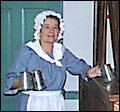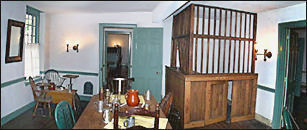|
HADDONFIELD, N.J. (May 16, 1999) -- In an event that marked a major milestone in its six-year interior restoration program, the Indian King Tavern Musem today unveiled a recreated version of the "cage" bar from which patrons were served liquor during the Revolutionary War.
Located in one of the two front rooms of the 249-year-old building, the new bar was hand-crafted by cabinetmaker Dennis Powell, one of more than two dozen local volunteer artisans who have built entire rooms full of authentic 18th-century furniture and accoutrements for the tavern that celebrates its 250th anniversary next year.
Church Donates Wood
The new feature was built with century-old oak from pews donated to the tavern by Haddonfield's First Presbyterian Church. While there are still many smaller tasks to be accomplished before the restoration is complete, the bar was the program's last major wooden construction project.

|
|
Indian King bar maid.
|
|
"This is a big event for us -- no 18th-century tavern recreation would be complete without a period bar," said William Mason, the site's Historic Preservation Specialist, who often leads tours dressed in the garb of a colonial innkeeper.
The "cage" or "frame" bar was a standard element of 18th-century colonial taverns. A closet-sized space walled off with panels of wooden bars, it protected the stores of whiskey, rum and wine while offering a secure storage space for other valuables and fragile items like punch bowls, glasses and decanters. The modern term "bar" -- referring to a public place where liquor is served -- evolved from this early structure in colonial taverns.
Locking Up the Liquor
"For the most part, the people who stayed in the rooms of a public house like the Indian King in 1777 were strangers to the innkeeper," explained Mason. "That innkeeper needed some means of preventing guests from wandering down in the middle of the night to freely sip his most valuable inventory. These types of barred enclosures could be locked up at night."
The Indian King's original cage bar survived until the first decade of the 1900s when it was removed during the tavern building's first historic renovation, according to Mason. Although the precise design of that bar was not documented, its exact size was apparent from the cuts and grooves still visible in the walls.
The new bar is based on the most common designs found in area taverns of the same period. Many New Jersey and Philadelphia-area tavern interiors have been documented in architectural plans, sketches and period descriptions gathered and studied by Mason and his group of volunteer cabinetmakers.
Knauer Collection of Tavern Measures
Although the basic bar structure is finished, it will soon get the interior shelving that an innkeeper would have used for behind-the-counter storage.
Mason said the new shelving will display the museum's Knauer Collection of Colonial Tavern Measures. Donated by Virginia Knauer, the sets of mug-like pewter measures made in England, Scotland and France were used in the 18th century to measure the amount of drink poured into the mugs of paying customers.
"These were the source of the expression, 'To get a full measure,'" explained Mason.
|


